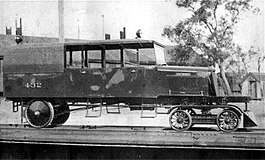The Port Hedland–Marble Bar railway was a railway in the Pilbara region of Western Australia, running into the hinterland from the north-west coast.
| Marble Bar Railway | ||||||||||||||||||||||||||||||||||||||||||||||||||||||||||||||||||||||||||||||||||||||||||||||||||||||||||||||
|---|---|---|---|---|---|---|---|---|---|---|---|---|---|---|---|---|---|---|---|---|---|---|---|---|---|---|---|---|---|---|---|---|---|---|---|---|---|---|---|---|---|---|---|---|---|---|---|---|---|---|---|---|---|---|---|---|---|---|---|---|---|---|---|---|---|---|---|---|---|---|---|---|---|---|---|---|---|---|---|---|---|---|---|---|---|---|---|---|---|---|---|---|---|---|---|---|---|---|---|---|---|---|---|---|---|---|---|---|---|---|
 WAGR AI class petrol rail motor used on Marble Bar Railway from 1934 to 1947 | ||||||||||||||||||||||||||||||||||||||||||||||||||||||||||||||||||||||||||||||||||||||||||||||||||||||||||||||
| Overview | ||||||||||||||||||||||||||||||||||||||||||||||||||||||||||||||||||||||||||||||||||||||||||||||||||||||||||||||
| Status | Closed | |||||||||||||||||||||||||||||||||||||||||||||||||||||||||||||||||||||||||||||||||||||||||||||||||||||||||||||
| Owner | WAGR | |||||||||||||||||||||||||||||||||||||||||||||||||||||||||||||||||||||||||||||||||||||||||||||||||||||||||||||
| Locale | Pilbara, Western Australia | |||||||||||||||||||||||||||||||||||||||||||||||||||||||||||||||||||||||||||||||||||||||||||||||||||||||||||||
| Termini | ||||||||||||||||||||||||||||||||||||||||||||||||||||||||||||||||||||||||||||||||||||||||||||||||||||||||||||||
| Stations | 12 | |||||||||||||||||||||||||||||||||||||||||||||||||||||||||||||||||||||||||||||||||||||||||||||||||||||||||||||
| Service | ||||||||||||||||||||||||||||||||||||||||||||||||||||||||||||||||||||||||||||||||||||||||||||||||||||||||||||||
| Type | Heavy rail | |||||||||||||||||||||||||||||||||||||||||||||||||||||||||||||||||||||||||||||||||||||||||||||||||||||||||||||
| System | WAGR | |||||||||||||||||||||||||||||||||||||||||||||||||||||||||||||||||||||||||||||||||||||||||||||||||||||||||||||
| Operator(s) | WAGR | |||||||||||||||||||||||||||||||||||||||||||||||||||||||||||||||||||||||||||||||||||||||||||||||||||||||||||||
| History | ||||||||||||||||||||||||||||||||||||||||||||||||||||||||||||||||||||||||||||||||||||||||||||||||||||||||||||||
| Opened | July 1911 | |||||||||||||||||||||||||||||||||||||||||||||||||||||||||||||||||||||||||||||||||||||||||||||||||||||||||||||
| Closed | 31 October 1951 | |||||||||||||||||||||||||||||||||||||||||||||||||||||||||||||||||||||||||||||||||||||||||||||||||||||||||||||
| Technical | ||||||||||||||||||||||||||||||||||||||||||||||||||||||||||||||||||||||||||||||||||||||||||||||||||||||||||||||
| Line length | 184 km (114 mi) | |||||||||||||||||||||||||||||||||||||||||||||||||||||||||||||||||||||||||||||||||||||||||||||||||||||||||||||
| Track gauge | 3 ft 6 in (1,067 mm) | |||||||||||||||||||||||||||||||||||||||||||||||||||||||||||||||||||||||||||||||||||||||||||||||||||||||||||||
| ||||||||||||||||||||||||||||||||||||||||||||||||||||||||||||||||||||||||||||||||||||||||||||||||||||||||||||||
History
editThe Port Hedland-Marble Bar Railway Act 1907, an act by the Parliament of Western Australia assented to on 19 September 1907, authorised the construction of the railway line from Port Hedland to Marble Bar.[1]
The line was a Western Australian Government Railways (WAGR) 3 ft 6 in (1,067 mm) gauge branch line which was isolated from the rest of the WAGR system. Construction was commenced in 1909, undertaken by the firm of Henry Teesdale Smith, and the line was opened in July 1911.[2][3]
The line had been proposed for some years before the date of opening.[4][5]
The closest railhead of the main WAGR rail system was over 1,000 kilometres (620 mi) to the south at Meekatharra so most rolling stock and materials were shipped in and out Port Hedland.
Due to heavy losses on the line, the Western Australian government asked 1922 Royal Commission of Inquiry into the Railway Department to make a specific inquiry into the running of the Port Hedland railway. The commissioner found that "the railway cannot be run effectively so long as it is administered by the Railways Department" and recommended, among other things, that the running of the line be handed over to the Commissioner of the North-West.[6] That was not done.
The reputation of the line for its slow running speed lived on long after the railway had closed, with Patsy Adam Smith's 1969 book about early railways noting the use of the ironic name the Spinifex Flyer.[7]
The Railway (Port Hedland-Marble Bar) Discontinuance Act 1950 was granted royal assent on 18 December 1950,[8] and the last train to run out of Port Hedland operated on 25 October 1951. The railway closed on 31 October 1951.
Iron ore railways that have subsequently been constructed in the Pilbara region are standard gauge railways.
See also
editReferences
edit- ^ "Port Hedland-Marble Bar Railway Act 1907". www.legislation.wa.gov.au. Government of Western Australia. 19 September 1907. Retrieved 10 August 2024.
- ^ "THE PORT HEDLAND-MARBLE BAR RAILWAY: TURNING THE FIRST SOD". Western Mail. Perth: National Library of Australia. 27 March 1909. p. 25. Retrieved 25 May 2012.
- ^ Woodland, Edwin W. (1975) The Port Hedland – Marble Bar Railway Australian Railway Historical Society Bulletin, January, 1975 pp1-6
- ^ Isdell, James; Thomson, James (James Wylie) (1904), Developing our resources : the great nor'-western railway : Port Hedland to Marble Bar and Nullagine : opening up the Pilbara goldfields, A.E. Forsaith, retrieved 25 May 2012
- ^ Anketell, R. J (1895), Report on proposed railway line Marble Bar to Port Hedland, and Cossack to Marble Bar, and plans, Govt. Pr, retrieved 25 May 2012
- ^ Stead, George W. (1922). Royal Commission Appointed to Inquire into the System of State Railways. WA Government Printer. Retrieved 25 May 2012. notably part 5, page 38 – 51 Report of the Royal Commissioner on the Port Hedland-Marble Bar Railway and Copy of Evidence taken. The response by the Commissioner of Railways, H.Pope, comprises section 6 – pages 52–53.
- ^ "ROMANCE OF THE RAILWAY PIONEERS". The Australian Women's Weekly. National Library of Australia. 16 April 1969. p. 14. Retrieved 25 May 2012.
- ^ "Railway (Port Hedland-Marble Bar) Discontinuance Act 1950". www.legislation.wa.gov.au. Government of Western Australia. 18 December 1950. Retrieved 12 August 2024.
Bibliography
edit- Affleck, Fred (1978). On Track: The Making of Westrail, 1950–1976. Perth: Westrail. ISBN 0724475605. OCLC 6489347.
- Joyce, John; Tilley, Allan (1980). Railways in the Pilbara (2nd ed.). Wembley, WA: J & A Publications. pp. 21–32. ISBN 0959969926. OCLC 222691305.
- May, Andrew S; Gray, Bill (2006). A History of WAGR Passenger Carriages. Midland, WA: Bill Gray. ISBN 0646459023.
- Quinlan, Howard & Newland, John R.(2000) Australian Railway Routes 1854-2000 ISBN 0-909650-49-7
External links
edit- https://www.abc.net.au/news/2016-08-11/archival-map-of-spinifex-express-route/7720178?nw=0 for archival map of the railway
- https://web.archive.org/web/20060820021925/http://railways.pilbara.net.au/index2.html for current railways in the Pilbara
